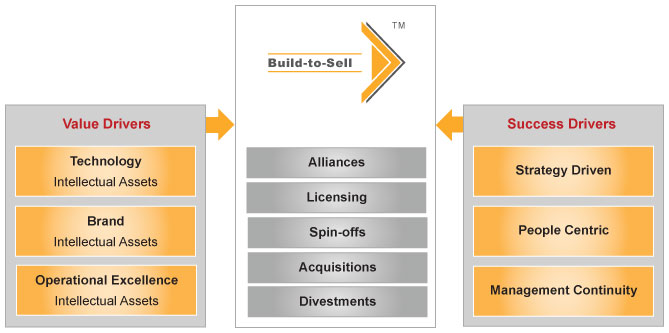Transaction Based Growth ManagementTM (TBGM)
In its engagements, Globalator embraces Transaction Based Growth ManagementTM, which encompasses the following four cornerstones:
- Build-to-Grow vs. Build-to-Sell choice
- Strategic transactions to speed-up growth
- Success drivers
- Value drivers
Cornerstone 1: Build-to-Grow vs. Build-to-Sell choice
The first cornerstone of the TBGM model is that a business needs to make a choice between a Build-to-Grow or Build-to-Sell strategy. It takes years to build a successful business that can last for generations (Build-to-Grow), but it also takes years to build a business that is optimized for an exit (Build-to-Sell). Making that choice early on (or at least choosing a preference) allows to allocate the resources in a way that it supports the chosen overall strategic direction.
Cornerstone 2: Strategic transactions to speed-up growth
Business growth that is entirely based on organic growth has its limitations from a growth speed perspective. Tapping into the resources of third parties through alliances, licensing and acquisitions allows a company to grow faster, especially when it comes to expanding into new markets. Spin-offs are an often underestimated tool to make more out of certain in-house assets, especially when one partners with a third party through a joint venture. Targeted divestments of resources that have been built, but no longer fit the strategy can provide additional cash to grow the business further without having to raise funds. All of these strategic transactions are part of the toolbox used during the development phase of your business towards an exit.
Cornerstone 3: Success drivers
There are three key success drivers for strategic transactions, including an overall choice of a Build-to-Sell strategy. The first success driver is to ensure that business growth is strategy driven and not opportunity driven. This does not mean to miss opportunities, as long as they fit the strategy. Moreover, strategic transactions should be people centric. They generally involve individuals from two different organizations that have to work together for a longer period of time. The difference between a best-case-scenario and a worst-case-scenario outcome from a strategic transaction comes from the people and the management thereof. Furthermore, strategic transactions to be done correctly have a significant development phase before the transaction happens and a significant implementation phase. Ideally the leadership position within the company does not change throughout the phases in order to achieve the best results. This is why it is the principle of Globalator to be on board with you throughout the whole journey of preparing your business for the exit until the implementation with the new owner is well on track.
Cornerstone 4: Value drivers
Intellectual assets are generally the key value drivers of a business and support the development and preservation of a sustainable competitive advantage. Technology intellectual assets include patents and trademarks (the IP component) that are coupled with team know-how (the enabling component). Brand intellectual assets include trademarks (the IP component) that are coupled with occupying a certain customer mindshare (the enabling component). Operational excellence includes operational systems (the IP component, although there is no real protection tool) that are coupled with the right company culture fueling the success of the business (the enabling component).
If you use a Build-to-Grow strategy your intent is to expand your company continue as a stand-alone entity; sometimes over several family generations. You can build your company organically from within, or you can use one or several strategic transaction types to advance your business. Especially when it comes to international expansion many companies use alliances, or at least some form of simple distribution arrangement. Depending on your specific situation all strategic transaction types can help you to grow your company faster and with lower risk, when managed properly.


